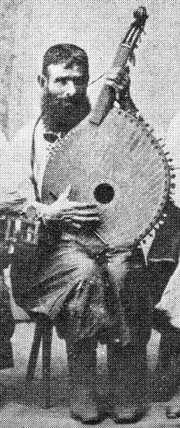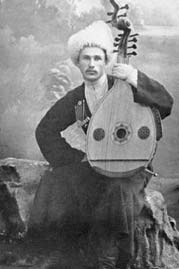|
Bandurists
A banduryst ( uk, бандури́ст) is a person who plays the Ukrainian plucked string instrument known as the bandura. Types of performers There are a number of different types of bandurist who differ in their particular choice of instrument, the specific repertoire they play and manner in which they approach their vocation. *Kobzari, who play authentic ethnographic instruments or copies. This group can also be further categorized into ''authentic'', ''reproduction'', and ''stage'' performers. *Academic players, playing more sophisticated contemporary concert banduras. These performers have a tertiary education majoring in bandura performance and typically perform works by Western classical composers in addition to, or instead of, Ukrainian folk music. This category can be further divided into instrumentalists (who only perform instrumental works) and vocalists (who primarily use the bandura to accompany their voice). The most common academic bandurists play in the Kiev aca ... [...More Info...] [...Related Items...] OR: [Wikipedia] [Google] [Baidu] |
Bandura
A bandura ( uk, банду́ра) is a Ukrainian plucked string folk instrument. It combines elements of the zither and lute and, up until the 1940s, was also often referred to by the term kobza. Early instruments (c. 1700) had 5 to 12 strings and similar to the lute. In the 20th century, the number of strings increased initially to 31 strings (1926), then to 56 strings – 68 strings on modern 'concert' instruments (1954).Mizynec, V. Folk Instruments of Ukraine. Bayda Books, Melbourne, Australia, 1987, 48с. Musicians who play the bandura are referred to as bandurists. In the 19th – early 20th century traditional bandura players, often blind, were referred to as kobzars. It is suggested that the instrument developed as a hybrid of gusli (Eastern-European psaltery) and kobza (Eastern-European lute). Some also consider the ''kobza'' as a type or an instrument resembling the ''bandura''. The term ''bandura'' can date itself to Polish chronicles from 1441. The hybridization, h ... [...More Info...] [...Related Items...] OR: [Wikipedia] [Google] [Baidu] |
Honcharenko Hnat
Hnat Tykhonovych Honcharenko (Гнат Тихонович Гончаренко, 1835–c. 1917) was one of the most renowned Ukrainian kobzars (blind itinerant minstrels) of the Kharkiv oblast of the late 19th and early 20th centuries. Biography Honcharenko was born in the village of Ripky into a serf family. He became blind at the age of 3 or 4. He began to study the bandura at the age of 22 under the old kobzar Petro Kulibaba. He studied for a period of four months, and continued his studies under other kobzars he later met. After he married, he settled not far from Kharkiv on the Hubayenko homestead. When he was widowed, he resettled to Sevastopol with his son, a railway engineer. Honcharenko would spend his winters there and return to Kharkiv for the summer months. Honcharenko had in his repertoire four '' dumy'', epic poems set to music: # Oleksiy Popovych # The Poor Widow and Her Three Sons # The Sister and Brother # About the Escape of the three brothers from Ozi ... [...More Info...] [...Related Items...] OR: [Wikipedia] [Google] [Baidu] |
Hryhory Bazhul
Hryhory Ivanovych Bazhul ( uk, Григорій Іванович Бажул transcribed as Georg Baschul) Note: Name was transcribed via German on Australian Government documents. (January 22, 1906 — October 17, 1989) was a Ukrainian bandurist and publisher of articles on bandura history from Poltava, Russian Empire.http://histpol.pl.ua/pages/content.php?page=1261 After World War II he emigrated to Australia settling in Sydney. Early life Hryhory Ivanovych Bazhul was born in the Poltava Governorate of the Russian Empire (in present-day Ukraine), his father was a rail road engineer and his family moved to Kharkiv in 1911. After completing his studies at the Institute of Grain Culture, he was employed as an agronomist.Dibrivny, I. "Григорій І. Бажул (некролог)", ''Вільна Думка'', Sydney, Australia, 12.ХІ.89 In the late 1920s he was arrested and spent 2 years of penal labour at the Berdyansk agricultural labour colony. On his return to Khar ... [...More Info...] [...Related Items...] OR: [Wikipedia] [Google] [Baidu] |
Petro Drevchenko
Petro Semenovych Drevchenko (1863 – 1934) was also known by the surname of Drevkin and Drygavka. Biography Drevchenko was born in 1863 in the Poltava Governorate of the Russian Empire (in present-day Ukraine) to a family of servants. From the age of 12 he lived in Kharkiv, in the area of Zalutin. At the age of 13 he came down with the mumps and lost his sight. At 14 he was apprenticed to kobzar Hnat Honcharenko for 4 years and at 18 completed his apprenticeship and received permission to become an independent kobzar. At the age of 20 he was married. Kryst wrote that Drevchenko reminded one of his teacher - Hnat Honcharenko. He had a fidgety character and was given the name Drygavka (meaning "spinning top"). He travelled around considerably giving numerous performances. Of the kobzars of the early 20th century he made public significant sections of the Ustynski books. He often performed with lirnyk Ivan Zozulia. He participated in the XIIth Archeological Congress in K ... [...More Info...] [...Related Items...] OR: [Wikipedia] [Google] [Baidu] |
Pavlo Hashchenko
Pavlo Ivanovych Hashchenko ( -1933) was a Ukrainian kobzar and bandura player. Hashchenko was originally from Poltava province but lived most of his life in the village of Konstantynivka, Bohodukhiv county, Kharkiv province. Among the kobzars of the Slobozhan region he was thought of as one of the best, and consequently he was invited to perform at the XIIth Archeological Conference held in Kharkiv in 1902. At that concert Hashchenko's solo performance included the satirical song "Popadia" and he performed in the ensemble with other kobzars. In 1905 Opanas Slastion painted a portrait of Hashchenko and noted that Hashchenko knew four '' dumy'' (sung epic poems). After the performance at the XIIth Archeological Conference Hashchenko performed at a numerous other kobzar A ''kobzar'' ( ua, кобзар, pl. kobzari ua, кобзарі) was an itinerant Ukrainian bard who sang to his own accompaniment, played on a multistringed bandura or kobza. Tradition Kobzars were of ... [...More Info...] [...Related Items...] OR: [Wikipedia] [Google] [Baidu] |
Ivan Kuchuhura Kucherenko
Ivan Iovych Kuchuhura-Kucherenko ( uk, Іван Іович Кучугура-Кучеренко; July 7, 1878 – November 24, 1937) was a Ukrainian minstrel (kobzar) and one of the most influential kobzars of the early 20th century. For his artistry he was awarded the title "People's artist of Ukraine" in 1919 and later "People's Artist of the Ukrainian Soviet Socialist Republic" in 1926. Biography Childhood Ivan Kucherenko (or as he later became known, ''Kuchuhura-Kucherenko'') was born on July 7, 1878 in the village of Murafa of Bohodukhiv uyezd in the Kharkov Governorate of the Russian Empire. At the age of 3, he became fully blind in his left eye and had some damage in his right eye. At the age of 8, he lost his father and became an orphan. The young Kucherenko had exceptional musical talent which directed him to the lifestyle of a kobzar. He was apprenticed to the kobzar Pavlo Hashchenko and began to perform as a kobzar at the turn of the 20th century. Education and ... [...More Info...] [...Related Items...] OR: [Wikipedia] [Google] [Baidu] |
Vasyl Yemetz
Vasyl' Kostovych Yemetz ( uk, Василь Костьович Ємець; 15 December or 27 December 1891 – 6 January 1982) (2 August 1890 – 4 January 1982) (also went by Wassyl, Vassyl) was born in the village of Sharivka, 40 km from Kharkiv, Ukraine. He was the son of Kost' and Yevdokia (Kurakhovych).Мішалов В. і М. — Українські кобзарі-бандуристи — Сідней, Австралія, 1986 He was married to Maria Hotra-Doroshenko. He was a virtuoso bandurist. He was founder and initial director of the Kobzar Choir in 1918 - the direct protégé of the Kiev Bandurist Capella and the Ukrainian Bandurist Chorus.Горлиця Л. — Василь Ємець — кобзар віртуоз, композитор // Вісті, № 34, 1970.Василь Ємець — творець першої української капели бандуристів, співак, бандурист, письменник http ... [...More Info...] [...Related Items...] OR: [Wikipedia] [Google] [Baidu] |
Kharkiv Style
The Kharkiv Academic Style of Bandura Playing is a specific method of playing the Ukrainian folk instrument bandura. The instrument is held in a way that allows both hands equal access to all the strings. Firstly, the left hand has access to the entire range of strings and is not restricted to holding the instrument as it is in other styles and secondly, the right hand similarly has access to play all the treble strings and also all the bass strings. The manner in which the instrument is held also influences the technique used by the bandurist. In some instances the left hand may use all five fingers in playing. The position in which the bandura is held also means that the 5th finger of the right hand can also be used with more dexterity than in the Kyiv style. The left hand has two positions for playing. The first position is such that the thumb is used to slide the hand along the edge of the instrument and allowing the remaining four fingers to pluck the strings and the second ... [...More Info...] [...Related Items...] OR: [Wikipedia] [Google] [Baidu] |
Kiev Academic Style
The Kyiv Academic Style of Bandura Playing is a method of playing the Ukrainian folk instrument of bandura. The instrument is held between the knees perpendicular to the body of the player. This means that the left hand is only able to play easily along the bass strings of the instrument. The right hand usually plays just on the treble strings known as ''prystrunky''. The manner in which the instrument is held influences the technique used by the bandurist. The left hand uses only the middle three fingers in play. The position in which the bandura is held also means that the 5th finger of the right hand cannot be used effectively. The Kyiv style is based on the technique used by kobzari of the Chernihiv province such as Tereshko Parkhomenko. It became known as the Kyiv style because the Kyiv Bandurist Capella used it. Before World War II, most Kyiv banduras had diatonically tuned bass strings. Since World War II in Ukraine, chromatic bass tuning is the standard. In the West, howe ... [...More Info...] [...Related Items...] OR: [Wikipedia] [Google] [Baidu] |
Ostap Veresai
Ostap Mykytovych Veresai ( uk, Остап Микитович Вересай) (1803–April 1890) was a renowned minstrel and kobzar from the Poltava Governorate (now Chernihiv oblast) of the Russian Empire (now Ukraine). He helped to popularize kobzar art both within Ukraine and beyond. He is noted for influencing both scholarly and popular approaches to minstrelsy. Biography Childhood Veresai was born in 1803 in the village of Kaliuzhentsi, Pryluky county, Poltava Governorate into a family of musicians. He was the only child of a serf family. His father, Mykyta Veresai, was a congenitally blind violinist. At age 4, Veresai fell ill and lost his sight. From an early age, Veresai was interested in music and the bandura. He was quoted later in life: "...when a kobzar came to my father's house, I would stand near him, and I do not know who was more excited. The kobzar would suggest: 'You Mykyto give this boy to learn, maybe he becomes a kobzar.'" At age 15, Veresai's father app ... [...More Info...] [...Related Items...] OR: [Wikipedia] [Google] [Baidu] |
.jpg)



